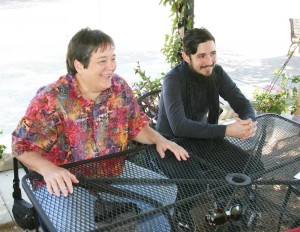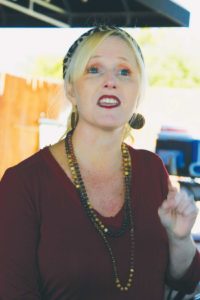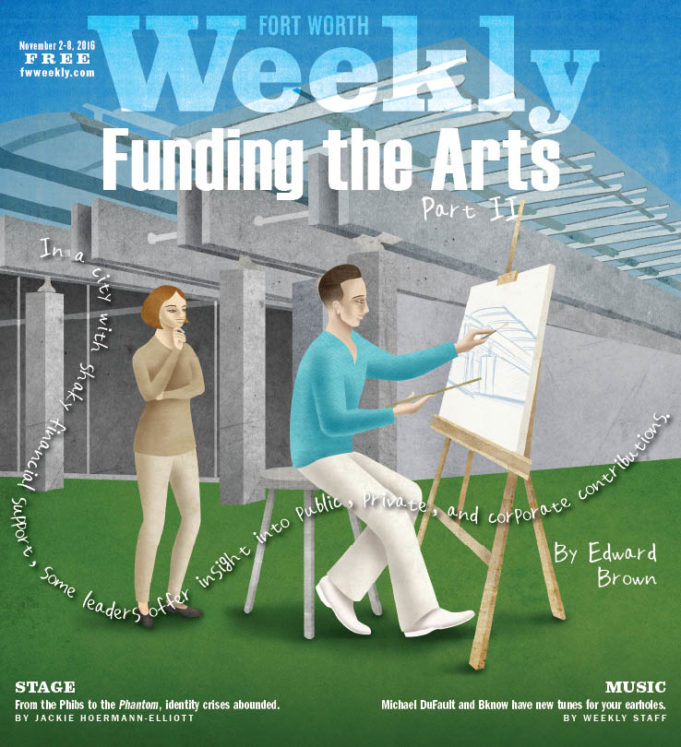Fort Worth’s reputation as a world-class art city owes a debt to four heavyweights: the Amon Carter Museum of American Art, the Kimbell Art Museum, the Modern Art Museum of Fort Worth, and the Sid Richardson Museum. But the city’s overall vibrant art scene is due to Fort Worth’s galleries, collectives, and public events like Gallery Night and Arts Goggle.
The consensus among the young artists I’ve spoken with is that Fort Worth is heading in the right direction but that there’s insufficient financial and institutional support for new, locally made works, especially installations and experiential pieces that don’t hang neatly on gallery walls. Many of these young artists are forging their own paths, putting hope in that old mantra: If you build it, they will come.
Emerging artists in Fort Worth navigate a cultural landscape that is both abundantly rich and difficult to break into. Life on the inside isn’t easy, either. City funding for the Arts Council of Fort Worth, the nonprofit tasked with disbursing public funds to several dozen groups, has been shaky at best.
City funding for the council’s grants went from $940,484 eight years ago to $549,690 in 2013. The cuts in 2013 coincided with an uptick in local political support for a then-proposed multipurpose arena in the Cultural District. Now under construction, the project is headed by local billionaire Ed Bass and is slated to open in late 2019. Public outcry ensued, and city officials proposed tying public arts funds to a sinking ship — royalties from oil and gas. Assistant city manager Fernando Costa recently said in an email that “those revenues” never materialized.
This year, the city budgeted a record $1.12 million for the Arts Council. The increase might be because of knowledge. Perhaps the holders of the purse strings have realized that the arts are not disposable. In a 2010 study, the advocacy group Americans for the Arts said that arts events generated more than $5 million in revenue for the local government and had a total economic impact of at least $84 million in Tarrant County. Results from a 2016 study will be released soon.
Last week, we explored problems related to funding performing arts groups. We’re tackling the issue now because the Fort Worth Symphony Orchestra’s recent financial straits reflect vulnerabilities endemic to every kind of group. One critical space, the Fort Worth Community Arts Center, is in need of extensive repairs. The Arts Council recently funded an assessment of the costs to repair the building. Those results will be released soon, said Arts Council President Karen Wiley. Former Arts Council president Jody Ulich estimated three years ago that it would take $30 million to overhaul and refurbish the 62-year-old building properly.

In conversations with arts leaders, both performing- and visual-based, the consensus is that the money is out there but that there needs to be more direct support from business and community leaders. For Part 2, I sat down with three influential visual arts players: Kendal Lake, communication manager for the Modern Art Museum of Fort Worth; Elaine Taylor, gallery manager of the Fort Worth Community Arts Center; and multimedia artist James Talambas, cofounder of the hybrid gallery project Art Tooth.
Weekly: Elaine, how is the Arts Center funded?
Taylor: The actual Fort Worth Community Arts Center building is owned by the city. The city funds the Arts Council [of Fort Worth]. We get $200,000 from the city [through the Arts Council] to manage our building. Our annual expenses are around $800,000.
Weekly: With $200,000 in city funds, how do you make up the other $600,000?
Taylor: We raise that money through individual donations given through the Arts Council. We have a new fundraiser February 28. It’ll be a one-night show with interactive art and performances. Also, we rent space. We have two theaters: Scott Theater with 500 seats and the Sanders Theater with 90 seats. We rent to individuals who want a concert space. … That’s a large part of our fundraising. The other part is the galleries. We have nine-and-a-half individual galleries. We have two galleries that are focus galleries. Those rotate exhibits every two months. The other seven galleries are rental galleries. We try to keep the rate low, but it still raises a lot of money. We have the Texas Artist Commission, which is a membership program that runs programs and exhibitions like an artist registry. They pay membership for that. So, all those things.
Weekly: You said the February fundraiser is the first one your group has done in a long time. Why?
Taylor: We have to be careful because we’re a program of the Arts Council. We don’t want to go after the same donors. We let the Arts Council do the bulk of the fundraising, and a portion of that comes back to us. Karen Wiley is extremely supportive of the Arts Center and wants us to be able to get some money. The February event will be ticketed.
Weekly: Kendal, what’s the funding structure at the Modern like? Has the ratio of funding from private, public, and corporate groups changed over the years?
Lake: Since we moved into our current building in 2002, our funding sources have been pretty stable. We don’t have ups and downs too much. We have endowments and individual and corporate giving. We have revenue sources from our store, café, and tickets. And we do facility rentals. We apply for grants that support our programming and exhibitions. We did receive some funding from the Arts Council this year. We rely on grants to cover shipping and insuring art for exhibitions, which is very expensive. [Texas Commission on the Arts] has supported us in the past. This year, we were awarded TCA’s cultural district grant.
Weekly: What were the criteria for applying for that grant?
Lake: It’s based on economic impact to a cultural district. We were given $450,000 to present [KAWS: Where the End Starts, the museum’s current exhibit]. It’s not a one-time only source, but it’s not guaranteed again either. This year, the Kimbell and the Modern each got $450,000. [Overall] Fort Worth got $900,000 for the arts, which is awesome. I’m sure they saw the synergy [between our two museums]. But that grant’s an outlier. We don’t exist on government support. We are in a private building, not a city building. Historically, Fort Worth has been so philanthropic that they established these museums. We weren’t established by a family foundation. We were founded by 25 women 125 years ago to bring culture to this city. Since then, it’s been a community-supported enterprise.
Taylor: Of course, you were formerly the Fort Worth Art Center.
Lake: Yes, we’ve changed names over time. The community, historically, has come out to support us. We’re lucky that way.
Weekly: Where does the biggest percentage of your funding come from?
Lake: From our trusts that have been established through individuals. We do get a nice revenue source from membership and individual giving and foundations. Trusts pay for maintenance and care of the building. Trusts pay for some operating, but buying artwork is completely separate. We do get some corporate help. Pier One always supports our Spring Break Arts Camp.
Weekly: Did the drop in oil and gas prices impact the Modern’s income?
Lake: I can’t give you specifics, because I’m not in the financial department, but there is a significant amount [of our funding] that varies with gas prices. When there are big fluctuations, we have to adjust. We have to raise funds elsewhere or cut our budget. We’ve been good at trying to streamline. The oil prices this year had an impact on our budget. The fact that we got the TCA grant was super helpful this year. It was a great year to get that grant because we needed it for the shortfall that came from oil and gas.
Weekly: How did you convince TCA that your museum was deserving of the grant?

Weekly: How do you measure the foot traffic and economic impact of your shows?
Lake: We partner with hotels and [the Fort Worth Convention and Visitors Bureau] to keep track of hotel nights to see if there are any upswings. I’d love to talk to the nearby business community to see if their business went up.
Weekly: If this leads to record attendance, does that help your grant applications next year?
Lake: Yes, KAWS has his following. Hopefully it’ll expand our audience in this community. That’s what we really need to work on. Because he’s such a phenom, hopefully it’ll expand our attendance continuously. That’s our goal.
Taylor: What is your average age of visitors to the Modern?
Lake: It skews young, especially for a museum. The average [museum age nationwide] is 54 to 65. If you went in there today, it’s so young. It does depend on our shows.
Talambas: And this is KAWS’ first retrospective, too.
Weekly: James, you’re here representing Art Tooth, a new collective helping young artists make their way into museums and galleries. Describe the challenges that younger artists face, especially the ones who don’t go the MFA or BFA route.
Talambas: Working artists have a lot of struggles, whether it’s how to get enough funding or how to get shown. There’s a huge divide between these working artists, who are on the poverty line often, and the potential support of oil and gas or financial money. Well, how do those groups come in contact with one another? I don’t think that middle ground is very well-established. Fort Worth is a younger art town as far as having that kind of support. So we’re just now getting enough new money in town, but we need to direct that new money.
Taylor: I think one of the problems, also, is that a lot of artists are working without offering a commodity. How do you get funding for something that isn’t an object that someone else can have? James, you do more performance-related work. A lot of people are doing installation works. Where do you get your daily bread when that’s the sort of work you do, unless you’re hitting at the museum level? It’s hard when you’re starting or even mid-range because there’s not financial support. In 2011, I started a small pop-up gallery thing in a house off of Camp Bowie [Boulevard]. We opened on Fall Gallery Night and had 500 people attend. We didn’t expect that amount. The neighbors complained, and we got shut down. One of the things Fort Worth is not good at dealing with is art that doesn’t just hang on the wall or an organization that isn’t widely recognized.
Weekly: I know several galleries that are doing fairly well selling art. How does the type of art you make affect your ability to sell it?
Talambas: Art Tooth is looking for people who are working less with background art, if I can be so bold to say.
Taylor: What do you mean by that?
Talambas: I think [established galleries], in general, show art that’s going to sell. It’s not stuff that’s very risky, I would say. All in all, we’re looking for riskier art that other, established galleries are less likely to take a chance on. It’s hard times for everybody, and they’re trying to run a business just like everyone. When you’re an establishment for 20, 30 years like Artspace [111] or William Campbell [Contemporary Art] or these other places that have an establishment base, you probably don’t want to alienate your audience by going on a risky bender for a week.
Lake: Are you describing outsider art?
Talambas: That’s a loaded term that the Webb Art Gallery [in Waxahachie] uses a lot. It’s not necessary outsider art, but we are trying to focus more on art that would be considered risky. The majority of pieces at the Modern were risky at one point before it jumped to being in the Modern.
Lake: Right.
Talambas: Where’s that ladder for Fort Worth artists? That’s what we’re trying to provide.
Taylor: I think that’s exactly what we need in Fort Worth, a ladder. Maybe you have a BFA and MFA or you’re out there creating. And then there’s the museum at the other end, which is maybe the ultimate goal for that sort of artist. Most of the galleries aren’t going to do something that isn’t going to support their bottom line. Why would they? I totally understand that.
Weekly: James, talk about galleries and some of the challenges of getting into them.
Talambas: We want to provide the first or second step of that ladder. A lot of it is networking and making a name for yourself, whether that’s through Instagram or hitting the pavement, so to speak, and knocking on doors and making your own way. Especially if you’re making more risky art, we’re trying to provide an avenue through which people can take those risks and put their stuff out there in a larger capacity.
Weekly: I know your approach is multifaceted. Explain why events like a mixer can be important to the career of an artist.
Talambas: The response we got to our mixer event [in July at my home] was greater than we anticipated. The amount of connections that were made has exponentially grown and helped the scene. But why have these things? They’re steps on the ladder.
Lake: I think the synergy and camaraderie that you have created is new to Fort Worth and so important. It’s not the elite group that has money. It’s a real group of artists who want to start something here.
Taylor: And it’s artist-run. We had an artist happy hour, and we were trying to figure out what is that next step to grow art in Fort Worth. One of the things we kept coming back to is that artists have to do it for themselves. We can’t wait for the director to come pick us off our chair. We have to make it for ourselves.
Lake: It’s genuine, and I think it’s something Fort Worth needs. It’s something the city, as an economic factor, should support, too, maybe through the Chamber [of Commerce]. Art draws businesses to places. That’s what made [West] Magnolia Avenue cool. It’s because they pulled these grassroots artists in.
Talambas: The next step is getting the city, these major institutions, to get behind these things. It’s not easy. While the artists can do everything they can, they can only take themselves so far if the elite in the city, who can sustain that, don’t show up and support it. I think that’s the connection that needs to be made.
Taylor: I think if you look at places where it’s been a success, you see that there has to be an individual, a foundation, or the actual city that steps forward. A larger chunk of money has to step forward and be there.
Weekly: How would you rate arts support from the city?
Talambas: I think our city has been doing well to support growth through [tax increment financing] and these new corridors, like the Near Southside. But it’s still under the idea that the money will trickle down. Artists need direct access to funding and a seat at the table, which they don’t have at the moment. You have seeder organizations like the Arts Council, but the ability for Joe Artist to have a say at that table is lacking.
Lake: The funds are not available for individual artists. That’s not how it’s structured.
Talambas: The [Dallas Office of Cultural Affairs] gives grants to individuals.
Lake: When it’s city-funded, the [Arts Council] may not want to fund something that might be controversial.
Taylor: I will say Fort Worth Public Art, a program of the Arts Council in cooperation with the city, is an incredible program that does funnel money to individual artists both local and national. That’s a program I’m very supportive of. We’re starting to see the fruits of our labors here. When I visited Philadelphia in the late ’80s, I was astounded by the amount of artwork just out for public view. It’s because they have this great public art program. We’re just starting to see that.
Lake: I think that story needs to be told to the community at large so they realize the value. It’s something you have to be told a lot of times because people don’t understand where that capital money is going to.
Taylor: Because we don’t have money for marketing, the Arts Center, Arts Council, and public art are some of the best kept secrets out there. … One of the things I’d like to see in Fort Worth is what [Contemporary Art Dealers of Dallas] does. I’d like to see us partner with the [Fort Worth Convention and Visitors Bureau] and create tour packages for people who come in town for the opera festival, conventions, the Cliburn, and other events. The package will take them to the Cultural District, and they can see the three museums. Then they can go to a studio or gallery. The package could include bus tickets. I know it’s complex, but CAD does it with their tours. Fort Worth takes visitors to the Stockyards. If they can take them to Billy Bob’s, why not also take them to us, especially if the people are already coming for these cultural events? My feeling is that people visit more if you hand the tour to them all completed. They don’t have to research. If you have something that’s going on at the convention center, you can offer a package and say for $100 your people will get to do these things. We’ll provide transportation, and you can have lunch at the Modern or wherever. Why can’t somebody do that? It may not make a great deal of money, but it would be so much better at highlighting all of Fort Worth, not just the cowboys.
Weekly: How do you convert people to buying art? There’s an entertainment factor to shows, but how do you remind people that this is how people make a living?
Lake: I have friends who look at art and ask, “Why would I pay $100 for that?” Really? Someone made that. They spent time making it. I don’t even know what to say to those people.
Taylor: There are seminars on how to train people to sell art and how to get people to buy it.
Lake: I think it’s our culture here, too. It seems there are more consumers that are willing to purchase art in other cities. If we want to get deep into the arts education system in Texas, that could be a factor.
Talambas: Arts education funding has been decreasing for the last two decades in schools.
Lake: In the Modern’s programs, we have free school tours always and more in-depth programs because we want to inform the lifelong bond of learning about art. Our Teen Artists Project, it’s very intensive, but these kids are going through it and getting that base. Museums are doing what they can, and the Amon Carter and Kimbell have great educational programs.
Weekly: James, at the recent Arts Goggle, Art Tooth sold prints by 10 artists at a pop-up art show. How successful was that?
Talambas: We did well. We sold about half the prints, especially the lower-priced pieces.
Weekly: Where have you found success converting fans into customers?
Talambas: What we’re trying to do is help people relate to it and to know the story behind the art. We’re looking for interesting stories. What can we take out of your artist’s experience, not just that you’re an artist but a person with a story? Then relating that to the buyers or would-be buyers and meeting them on their terms. They may enjoy it on one level, but let’s talk some more and get them more involved. And then, now you can find that this piece means more to you than just being a pretty picture. It is a pretty picture, but for art culture in general, it’s about having that relationship and having it where it means so much more to you so [collectors] can tell the story to their friends. How does it relate to a potential buyer’s life outside the picture? That’s how art creates meaning, and that’s how you go from a culture vulture to an arts buyer.
Taylor: I would say some artists are very eloquent about telling their story and others are not at all.
Lake: For the majority of artists, it’s not their personality that people are buying. But somehow they’ve connected with people.
Taylor: Sometimes you make that instant connection to the work. Other times it’s the familiarity of seeing that work or the artists again and again. Those two things work together. There are people whose work I may not appreciate at first, but I begin to as I get to know the artists and see the progression of their work or the whole context. If they speak well, that’s one thing. But some of them don’t, and you have to pull it out. But it takes that exposure. If you don’t have exposure, you never get to that point. So it’s up to the galleries, museums, and groups to bridge that. Some artists make fun of the idea of exposure for exposure’s sake. It’s not always worth it. Sometimes it is worth it to get that work out there again and again, to breed that familiarity.
Weekly: Part of what you all are fighting is a perception that art is a luxury. What do you remind your friends about art’s role in our community?
Taylor: There’s an illusion that it’s not necessary, that it’s a luxury. One of the first things humans did when they got beyond sustenance was to start decorating, carving, and making art. It’s a necessary part of human existence. It’s part of civilization. If you don’t have art, you don’t have civilization. l











